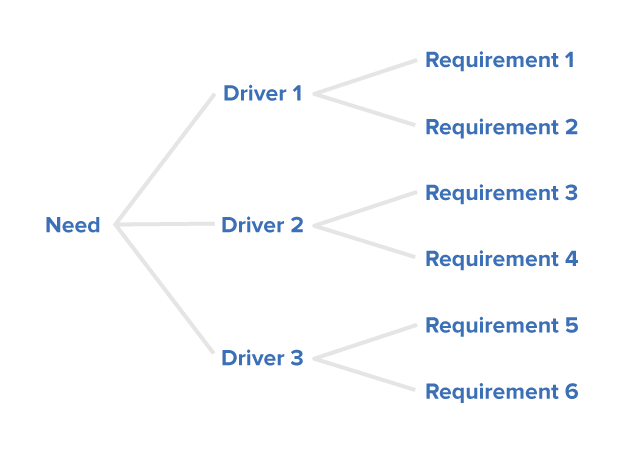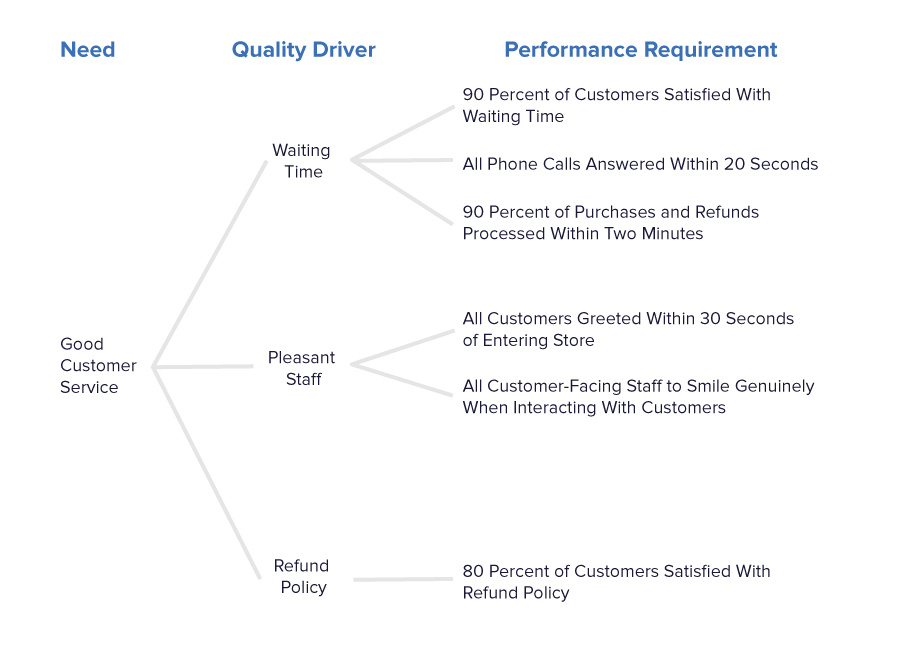Critical to Quality (CTQ) Trees
Translating Broad Customer Needs Into Specific Requirements

© iStockphoto
AVTG
Critical to Quality (CTQ) Trees can help you to design customer-centric, quality products.
Whether you're developing a new product or service, or refining one, quality is important – not only to your customers, but also to ensure that you stay ahead of the competition.
But defining quality can be challenging. Your definition quality may be very different from your customer's definition or even your colleagues. But this can make it all too easy to overlook factors that are a "must-have" for your customers.
Critical to Quality (CTQ) Trees can help you to understand what drives quality in the eyes of your customers, so that you can deliver goods that they not only need, but want!
About CTQ Trees
Critical to Quality (CTQ) Trees (as shown in figure 1, below) are diagram-based tools that help you to develop and deliver high-quality products and services. You can use them to translate broad customer needs into specific, actionable and measurable performance requirements.
For example, an instruction such as "improve customer service" is too broad to do much with. However, by using a CTQ Tree, you can drill-down from this broad goal jnto more specific, measurable requirements that you must deliver in order to meet customer needs.
CTQ Trees were originally developed as part of the quality and process improvement model, Six Sigma. You can use CTQ Trees to help clarify the qualities and characteristics of a product or service that are seen as essential by your customers.
Figure 1 – A CTQ Tree

CTQ Trees work by breaking down customer needs into three component areas:
- Needs – what must your product or service deliver for customers to be happy? For example, a critical need for a donut shop might be "Must deliver donuts that taste and look great."
- Drivers – for each need, you must also consider the quality drivers. These are the factors that customers will use to evaluate the quality of your product or service. For example, drivers here could be "Produce fresh donuts" or "Use quality ingredients."
- Requirements – these are the measurable, performance requirements that each driver must satisfy in order to provide a high-quality product or service to your customers. For example, measurable requirements for our donut shop could include, "Use packaging that keeps donuts fresh" or "Design a regular menu of ten donuts based on our bestseller list/data."
It is best to do a CTQ Tree for each individual critical need that you identify. You'll then have a comprehensive list of requirements that you can use to deliver a product that truly delights your customers.
How to Use CTQ Trees
We'll now look at a step-by-step process you can use to develop your own CTQ Tree:
Step 1: Identify Your Customers' Critical Needs
You first need to identify the critical needs that your product must meet in order to fulfil customer expectations. Do a CTQ Tree for every need that you identify.
During this first step, you're essentially asking, "What are the essential customer needs of our customers in relation to our product or service?"
It's best to define these needs in broad terms; this will help to ensure that you don't miss anything important in the next steps.
Do this by gathering as much information together as possible about your customers. Do surveys and questionnaires, host focus groups and gather customer-focused data. It's also a good idea to brainstorm customer needs with people who deal with customers directly – sales people and customer experience personnel.
Tip:
Perceptional Positions is another useful tool you can use to further explore the needs of your customers, particularly if people are struggling to move from an engineering mindset to a customer-focused mindset.
Step 2: Identify Quality Drivers
Next, identify the specific quality drivers that have to be in place to meet the needs that you identified in Step 1. Remember, these are the factors that must be present for customers if they are to agree that your product or service meets their quality standards.
Don't rush this stage – it's important that you identify all of the drivers that are important to your customers.
Again, speak to people in your organization who have customer-centric role, and ask customers directly for feedback on what factors are most important to them.
Tools such as Kano Analysis and the Five Product Levels may also be useful, as they can help you to identify product features that will delight your customers.
Step 3: Identify Performance Requirements
Finally, you need to identify the minimum performance requirements that you must satisfy for each driver that you listed in Step 2 and to deliver a product that fulfils all quality specifications.
Here it's important to think about your limitations. Remember that there are many things that will affect your ability to deliver on all they key quality requirements outlined. For example, do you have enough resources or the right technology in place? And, what will you need to do in other parts of your organization to meet these requirements?
Once you've completed a CTQ Tree for each critical need, you'll have a list of measurable requirements that you must meet to deliver a high-quality product.
CTQ Tree Example
Jesse is launching a store that sells baby clothing. After speaking with potential customers, one of the critical needs she identifies is "Good Customer Service." So she uses a CTQ Tree to create a list of measurable performance requirements that will help her to achieve this.
Jesse's CTQ Tree is shown below, in figure 2.
Figure 2 – Jesse's Example CTQ Tree

Key Points
A Critical to Quality (CTQ) Tree is a diagram-based tool you can use to clarify customer needs and understand more about the specific, measurable performance requirements you need to meet to fulfil those needs.
You use the tool by breaking down your customer needs into three components parts:
- Needs – the critical needs of your customers.
- Drivers – the quality drivers that need to be in place to meet those needs.
- Requirements – the specific, measurable requirements that each driver must satisfy, if you are to provide a high-quality product to customers.
Do a CTQ Tree for every customer need that you identify. You'll then have a comprehensive list of performance requirements that you'll need to meet to ensure your products are of the quality that your customers want and need.
This site teaches you the skills you need for a happy and successful career; and this is just one of many tools and resources that you'll find here at Mind Tools. Subscribe to our free newsletter, or join the Mind Tools Club and really supercharge your career!






Thanks for your positive comment. We're happy to hear you found the article useful. Please let us know if you need help around the club. We'd love to see you on the forums too!
Yolandé
Mind Tools Team
I am a huge fan of frameworks and models and often use them as tools for analysis or for design. We're glad that you found a model that demonstrates what you intuitively describe in your marketing classes.
Michele
Mind Tools Team